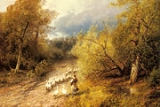
Hermann Ottomar Herzog
Encyclopedia


European ethnic groups
The ethnic groups in Europe are the various ethnic groups that reside in the nations of Europe. European ethnology is the field of anthropology focusing on Europe....
and American
United States
The United States of America is a federal constitutional republic comprising fifty states and a federal district...
artist
Artist
An artist is a person engaged in one or more of any of a broad spectrum of activities related to creating art, practicing the arts and/or demonstrating an art. The common usage in both everyday speech and academic discourse is a practitioner in the visual arts only...
, primarily known for his landscape
Landscape art
Landscape art is a term that covers the depiction of natural scenery such as mountains, valleys, trees, rivers, and forests, and especially art where the main subject is a wide view, with its elements arranged into a coherent composition. In other works landscape backgrounds for figures can still...
s. He was born in Bremen, Germany
Germany
Germany , officially the Federal Republic of Germany , is a federal parliamentary republic in Europe. The country consists of 16 states while the capital and largest city is Berlin. Germany covers an area of 357,021 km2 and has a largely temperate seasonal climate...
and entered the Düsseldorf Academy at age seventeen. Herzog achieved early commercial success, allowing him to travel widely and continue his training. His patrons included royalty and nobility throughout Europe.
In the late 1860s, after an extensive trip to Norway
Norway
Norway , officially the Kingdom of Norway, is a Nordic unitary constitutional monarchy whose territory comprises the western portion of the Scandinavian Peninsula, Jan Mayen, and the Arctic archipelago of Svalbard and Bouvet Island. Norway has a total area of and a population of about 4.9 million...
, Herzog settled permanently near Philadelphia in the United States
United States
The United States of America is a federal constitutional republic comprising fifty states and a federal district...
. Thereafter, he traveled throughout the U.S. and Mexico. He painted his way across the western states, arriving in California in 1873. His works from this trip included a series of Yosemite Valley
Yosemite Valley
Yosemite Valley is a glacial valley in Yosemite National Park in the western Sierra Nevada mountains of California, carved out by the Merced River. The valley is about long and up to a mile deep, surrounded by high granite summits such as Half Dome and El Capitan, and densely forested with pines...
paintings. In 1876, he received an award at the Philadelphia Centennial Exhibition for his painting of Sentinel Rock
Sentinel Rock
For the granite dome near Glacier Point, Yosemite National Park, see Sentinel Dome.Sentinel Rock is a granitic peak in Yosemite National Park, California, United States. It towers over Yosemite Valley, opposite from Yosemite Falls....
in Yosemite. Herzog also made extensive trips to Maine
Maine
Maine is a state in the New England region of the northeastern United States, bordered by the Atlantic Ocean to the east and south, New Hampshire to the west, and the Canadian provinces of Quebec to the northwest and New Brunswick to the northeast. Maine is both the northernmost and easternmost...
and Florida
Florida
Florida is a state in the southeastern United States, located on the nation's Atlantic and Gulf coasts. It is bordered to the west by the Gulf of Mexico, to the north by Alabama and Georgia and to the east by the Atlantic Ocean. With a population of 18,801,310 as measured by the 2010 census, it...
to paint.
Because he was a prudent investor, Herzog did not have to depend on the sale of his artwork to maintain a comfortable lifestyle. Following his death, his family retained a large group of his paintings, most of which were released to the art market in the 1970s. A number of prominent American and European museums now include Herzog's work as part of their collections.
Herzog's work is sometimes considered to be part of the Hudson River School
Hudson River school
The Hudson River School was a mid-19th century American art movement embodied by a group of landscape painters whose aesthetic vision was influenced by romanticism...
, although it is more realistic and less dramatic than works by peers Frederick Edwin Church or Albert Bierstadt
Albert Bierstadt
Albert Bierstadt was a German-American painter best known for his lavish, sweeping landscapes of the American West. In obtaining the subject matter for these works, Bierstadt joined several journeys of the Westward Expansion...
.
He almost always signed his work "H. Herzog"; as a result, his first name is spelled both "Herman" and "Hermann" in various sources. His birth year is sometimes incorrectly reported as 1831, but 1832 is proven correct by the civil birth registration of Bremen.
The Brandywine River Museum
Brandywine River Museum
The Brandywine River Museum is a museum of regional and American art located on U.S. Route 1 in Chadds Ford, Pennsylvania on the banks of the Brandywine River. The museum showcases the art of Andrew Wyeth a major American realist painter, and his family: his father, N.C...
in Chadds Ford, Pennsylvania held a major exhibition of Herzog's work in 1992 and published a catalog of his work, with an essay by art historian Donald S. Lewis, Jr.
In his long life, Herzog created more than 1,000 paintings, including "Women in a Tropical Setting" and "Landscape with a Bear and her Cub".

